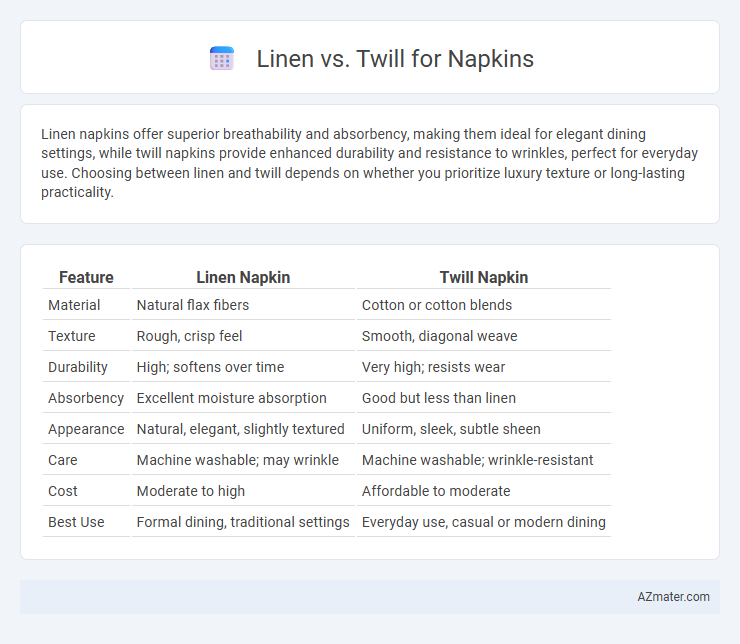Linen napkins offer superior breathability and absorbency, making them ideal for elegant dining settings, while twill napkins provide enhanced durability and resistance to wrinkles, perfect for everyday use. Choosing between linen and twill depends on whether you prioritize luxury texture or long-lasting practicality.
Table of Comparison
| Feature | Linen Napkin | Twill Napkin |
|---|---|---|
| Material | Natural flax fibers | Cotton or cotton blends |
| Texture | Rough, crisp feel | Smooth, diagonal weave |
| Durability | High; softens over time | Very high; resists wear |
| Absorbency | Excellent moisture absorption | Good but less than linen |
| Appearance | Natural, elegant, slightly textured | Uniform, sleek, subtle sheen |
| Care | Machine washable; may wrinkle | Machine washable; wrinkle-resistant |
| Cost | Moderate to high | Affordable to moderate |
| Best Use | Formal dining, traditional settings | Everyday use, casual or modern dining |
Introduction: Linen vs Twill Napkins
Linen napkins are prized for their natural fiber composition, breathability, and durability, making them ideal for formal dining settings. Twill napkins feature a distinctive diagonal weave that enhances fabric strength and crease resistance, providing a smooth drape and elegant texture. Both materials offer unique benefits: linen excels in absorbency and a classic look, while twill napkins are favored for their wrinkle resistance and long-lasting shape retention.
Fabric Composition and Characteristics
Linen napkins are made from natural flax fibers, offering excellent breathability, moisture-wicking properties, and a slightly coarse texture that softens with use. Twill napkins are woven using a distinctive diagonal weave, typically from cotton or cotton blends, providing enhanced durability, wrinkle resistance, and a smooth, sturdy surface. Both fabrics excel in absorbency, but linen's natural fiber composition gives it superior strength and a luxurious feel, while twill's weave structure delivers long-lasting performance and easy care.
Appearance and Texture Differences
Linen napkins feature a natural, slightly rough texture with a matte finish, offering an elegant yet rustic appearance ideal for both casual and formal settings. Twill napkins display a distinctive diagonal weave pattern that creates a smooth, soft texture with subtle sheen, adding a refined and polished look to the table. The heavier weight and tighter weave of twill provide enhanced durability and resistance to wrinkles compared to the looser, breathable weave of linen.
Durability and Longevity
Linen napkins offer moderate durability with natural fibers that soften over time, making them ideal for light to moderate use. Twill fabric napkins, made from tightly woven cotton or synthetic fibers, provide superior durability and resistance to wear, perfect for high-traffic dining environments. The diagonal weave of twill enhances longevity, preventing fraying and maintaining firmness after repeated washes.
Absorbency and Stain Resistance
Linen napkins offer superior absorbency, making them ideal for quickly soaking up spills due to their natural fiber composition and open weave structure. Twill napkins, typically made from cotton or cotton blends, are less absorbent but provide enhanced stain resistance thanks to their tightly woven diagonal pattern that repels liquids more effectively. Choosing between linen and twill involves balancing the need for high absorbency with the preference for easier stain management in everyday use.
Ease of Care and Maintenance
Linen napkins require gentle washing and ironing to maintain their natural texture and prevent wrinkles, often needing dry cleaning or delicate hand-washing cycles. Twill napkins offer greater ease of care with their durable, wrinkle-resistant weave that withstands frequent machine washing and tumble drying without losing shape. The tightly woven cotton or polyester fibers in twill make it more resistant to stains and easier to maintain compared to the more delicate linen fabric.
Cost Comparison
Linen napkins typically cost more due to their natural fiber content, durability, and luxurious texture, with prices ranging from $5 to $15 per napkin depending on quality. Twill napkins, made from cotton or polyester blends, are generally more affordable, often priced between $2 and $7 per napkin, offering cost-effective durability and easier maintenance. The higher initial investment in linen napkins is often justified by their longevity and elegant appearance, while twill napkins provide budget-friendly options suitable for everyday use or high-volume settings.
Environmental Impact
Linen napkins are highly sustainable, derived from flax plants requiring minimal water and pesticides, making them eco-friendly and biodegradable. Twill napkins, often made from cotton or synthetic blends, typically demand more water and chemicals during cultivation and production, increasing their environmental footprint. Choosing linen over twill reduces resource consumption and promotes a lower carbon footprint in sustainable table linens.
Popular Uses in Dining Settings
Linen napkins are favored in upscale dining settings for their natural fibers, breathability, and elegant texture, making them ideal for formal dinners and fine dining restaurants. Twill napkins, known for their durable weave and stain resistance, are popular in casual dining venues and high-traffic environments such as bistros and cafeterias. The choice between linen and twill often depends on the desired balance between sophistication and practicality in various dining atmospheres.
Choosing the Best Napkin Material for Your Needs
Linen napkins offer a natural, breathable fabric with high absorbency and elegant texture, ideal for formal dining or eco-friendly preferences. Twill napkins, made from tightly woven cotton fibers, provide durability and resistance to wrinkles and stains, making them perfect for everyday use and heavy laundering. Selecting between linen and twill depends on your need for sophistication and absorbency versus practicality and durability in napkin performance.

Infographic: Linen vs Twill for Napkin
 azmater.com
azmater.com